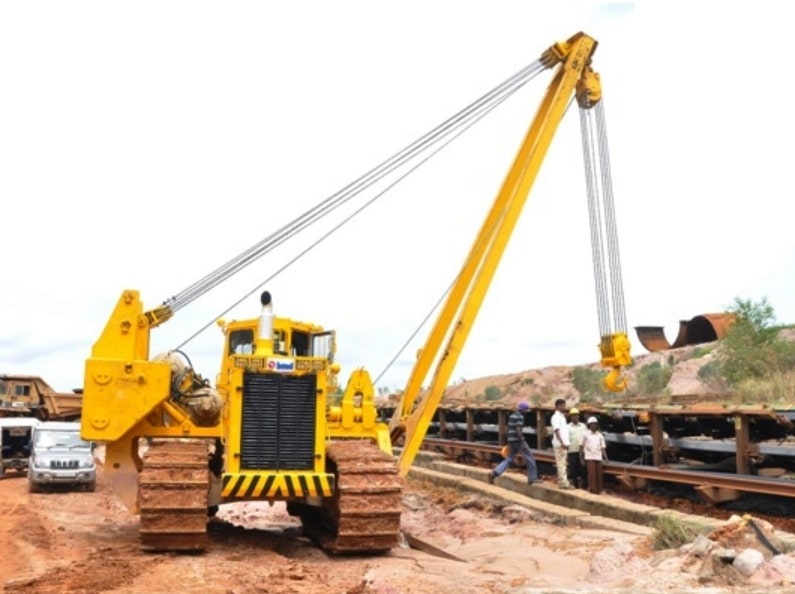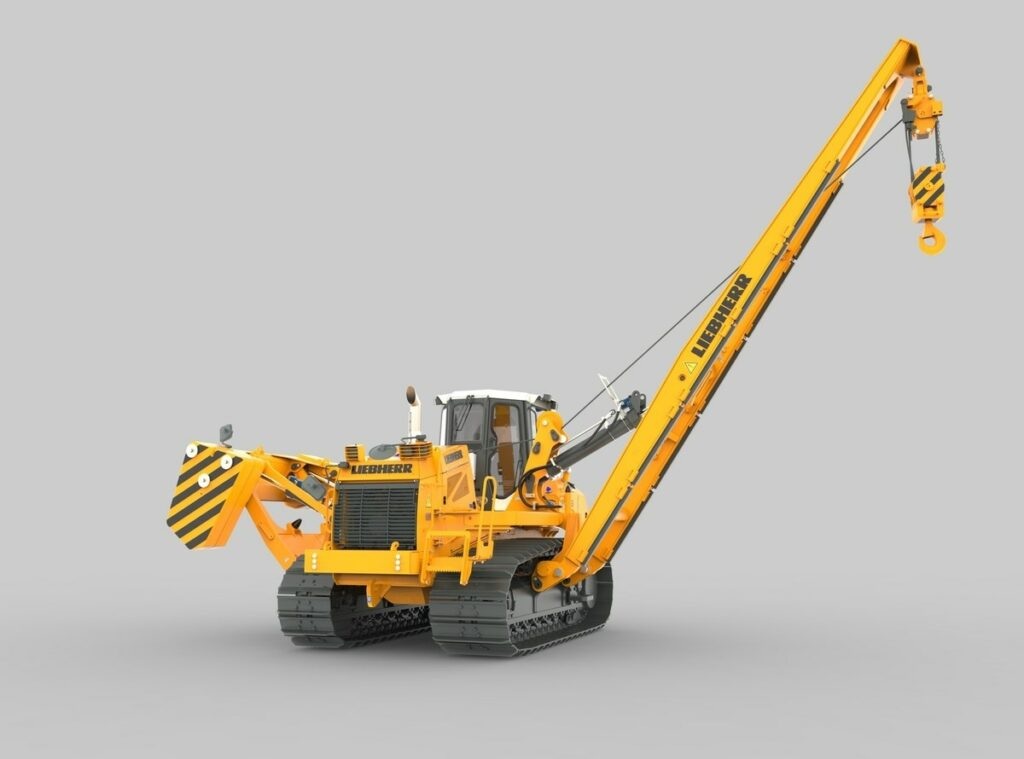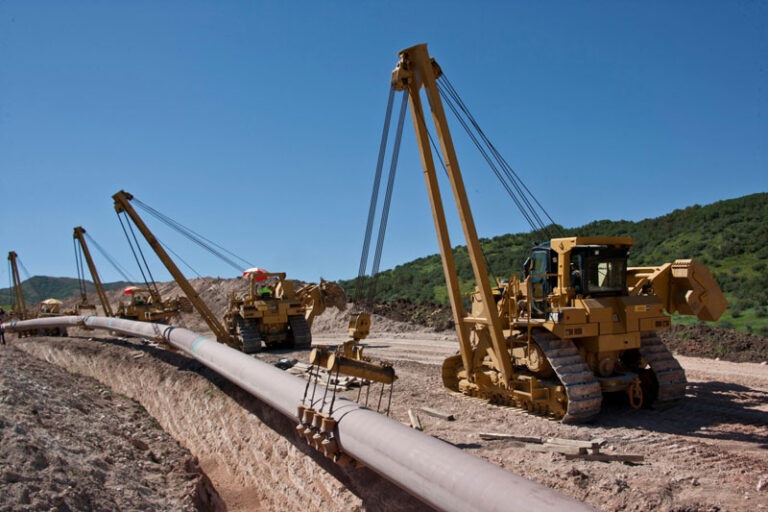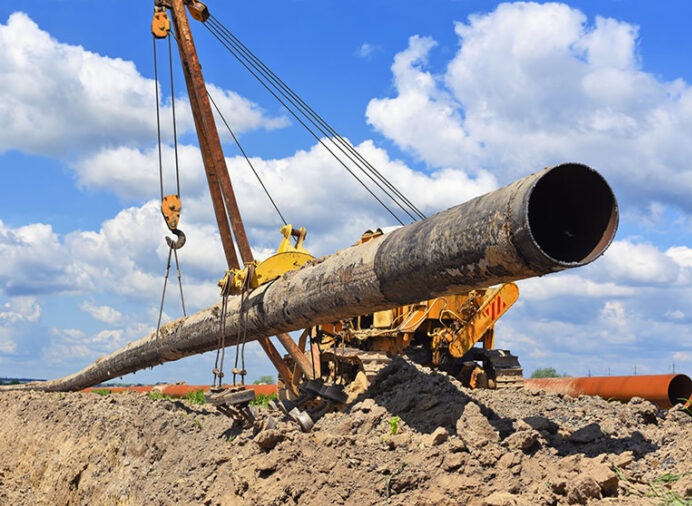Pipe laying is of utmost importance for infrastructure development, ensuring access to clean water and proper sanitation. Proper pipe laying is also crucial for the construction of sewer systems that transport and manage wastewater and sewage. A pipelayer is used for execution of pipe laying across industries. It is a type of heavy construction equipment used in the process of laying and installing pipes, typically for underground utility systems. The primary function of a pipelayer is to transport and lay large-diameter pipes in trenches or over difficult terrain. It is used to lift, move, and lower pipes into place with precision.
Components of pipelayers
- Boom: The boom is an extendable arm or crane-like structure mounted on the pipelayer. It is used to lift and position the pipes during installation.
- Counterweight: Pipelayers are equipped with a counterweight at the rear of the machine to provide stability and balance when handling heavy pipes.
- Load Line Winch: A load line winch is a powered drum or reel that uses cables or ropes to lift and lower pipes. It allows controlled lifting and precise placement of the pipes into trenches.
- Load Line Block: The load line block is a pulley system through which the lifting cables or ropes pass. It helps guide and distribute the load during lifting operations.
- Pipe Handling Attachment: This specialised attachment is connected to the boom and is designed to securely grip, lift, and position pipes. The attachment may include pipe hooks, clamps, or spreader bars, depending on the specific pipelayer model.
- Crawler Tracks: Pipelayers are typically equipped with crawler tracks instead of wheels for improved manoeuvrability and traction, especially in challenging terrains.
- Operator Cab: The operator cab is where the operator controls the pipelayer’s movements and operations. It provides a comfortable and safe environment with controls, instrumentation, and visibility features.
Pipelayers come in various sizes and configurations to accommodate different pipe diameters and project requirements.

Advantages of pipelayers
- The specialised boom and counterweight system allow for precise positioning of pipes, reducing the need for manual labour and speeding up the installation process.
- Designed to handle and transport large and heavy pipes. The load capacity varies depending on the model and specifications of the equipment. Some pipe layers can handle pipes weighing several tons.
- Equipped with additional attachments or implements for trenching and excavation. These may include buckets, rippers, or trenchers to prepare the ground and create a suitable trench for pipe installation.
- Incorporate safety features such as alarms, cameras, and proximity sensors to ensure the safety of the operator and nearby workers. These features help to prevent accidents and promote safe working conditions.
- Reduces the physical strain on workers and helps prevent injuries and accidents that can occur during pipe installation.
- Designed to handle various pipe sizes and types. It can accommodate a wide range of pipes, including those made of different materials like steel, concrete, or plastic. This versatility allows for greater flexibility in construction projects.
- Can operate in various terrains, including rough or uneven surfaces. The tracked vehicle offers excellent traction and stability, allowing it to manoeuvre through difficult conditions such as soft soils or steep inclines.
Different types of pipelayer models
Pipelayers with electro-hydraulic systems
The latest range of pipelayers comes with integrated electro-hydraulics that offer precise control to the variable speed motors of the heavy-duty winch for greater machine productivity. The machines are manufactured for large pipe diameter work and heavy lifting with a variety of features that are purpose-built for increased lift capacity, enhanced slope capability, and side-to-side stability. Oil-disc brakes provide smooth operation and positive retention of boom and hook positions. A modular pin-on design allows for fast removal and easy field service. Interchangeable parts between hook and boom winch assemblies help reduce cost and downtime. The winch profile is compact and enhances visibility. The lightweight, durable boom features high tensile strength steel construction for narrow structures and maximum visibility to the work area. The Pipelayer mainframe is engineered to handle the most demanding applications. The purpose-built pipelayer mainframe is built to absorb high-impact shock loads and twisting forces, and full box section frame rails are designed to keep components rigidly aligned. Rollover Protection Structure (ROPS) provides added operator protection for open or enclosed operator stations. The model’s heavy-lifting components include hook and boom blocks with sleeve bearings, a forged hook with latch and serviceable handle, and ductile iron sheaves.

Pipelayers with load sensing control system
The latest models come with a hydraulic control “Load Sensing” feature that enables precise positioning. It is useful both when welding the pipe sections together and when lowering the pipe strings, as well as during repair work. Depending on requirements, operating modes are available for maximum performance or particularly fuel-efficient operation. The hydrostatic drive operates automatically and adjusts the working speed to the required traction. The continuous friction, smooth drive, and boom control via a lifting cylinder prevent the machine from swinging up. This makes pipelayers ideal for driving on steep terrain or for embankment work. When working in confined spaces, all steering movements of the model are quick and easy to make until turning on the spot. In conjunction with the boom, even the heaviest of pipes can be easily swung to the side, even on damp and difficult ground. A variety of boom lengths are available for pipelayers, enabling larger work areas to be covered. In addition to an optional extended drawbar, hydrostatic cable winches can be fitted to the rear of the main frame. It is also possible to operate generators and use pipe-facing machines and telescopic cranes. This increases the versatility of the machine on the construction site.
Pipelayers with powershift transmission
Powershift transmission features in the latest models offer precise control over the movement and operation of pipelayers. The ability to shift gears smoothly and quickly allows operators to navigate various terrains and work with optimal precision. Powershift transmission with single lever control in the machines also allows for seamless directional changes in pipelayers, enabling operators to move and position pipes with accuracy and control. The ability to shift gears without interrupting power flow ensures smooth and uninterrupted operation during critical tasks. The hydraulic interlink steering system of the model offers ease of movement during gradual and sharp turns. It also comes equipped with hydraulically operated winches for easy raising and lowering of attachments.

Application of pipelayers
Pipelayers have a range of applications in various industries and construction projects. Here are some common applications of pipelayers:
Pipeline Construction: Pipelayers are extensively used in the construction of pipelines for transporting oil, gas, water, or other materials. They are employed to handle and position pipes into trenches, ensuring accurate alignment and placement. Pipelayers play a crucial role in efficiently laying out and joining pipe segments to create a continuous pipeline.
Pipeline Maintenance and Repair: Pipelayers are also utilised in pipeline maintenance and repair operations. They are used to lift and replace damaged sections of pipes, perform welding or joint repairs, and handle other maintenance tasks.
Water and Wastewater Projects: Pipelayers are involved in water and wastewater infrastructure projects, such as the installation of water supply lines, sewage pipelines, and drainage systems. They are used in placing pipes in trenches and supporting the construction and expansion of water treatment plants and distribution networks.
Mining and Quarrying: Pipelayers find applications in mining and quarrying operations. They are used for handling and positioning large-diameter pipes required for transporting minerals, slurry, or waste materials.
Infrastructure: Pipelayers play a role in various infrastructure projects that involve large-scale construction. They assist in handling and installing pipes required for bridges, tunnels, underground structures, and other civil engineering projects.
Land Reclamation and Dredging: In land reclamation projects and dredging operations, pipelayers are utilised to handle and position pipes used for soil stabilisation, drainage systems, or sediment transport.
Pipelayers are also used in the oil and gas industry for pipeline construction and maintenance.
Conclusion
Discussed above are different components, advantages, model types and applications of pipelayers.
Image Source: bemlindia.in, liebherr.com, gmmco.in


